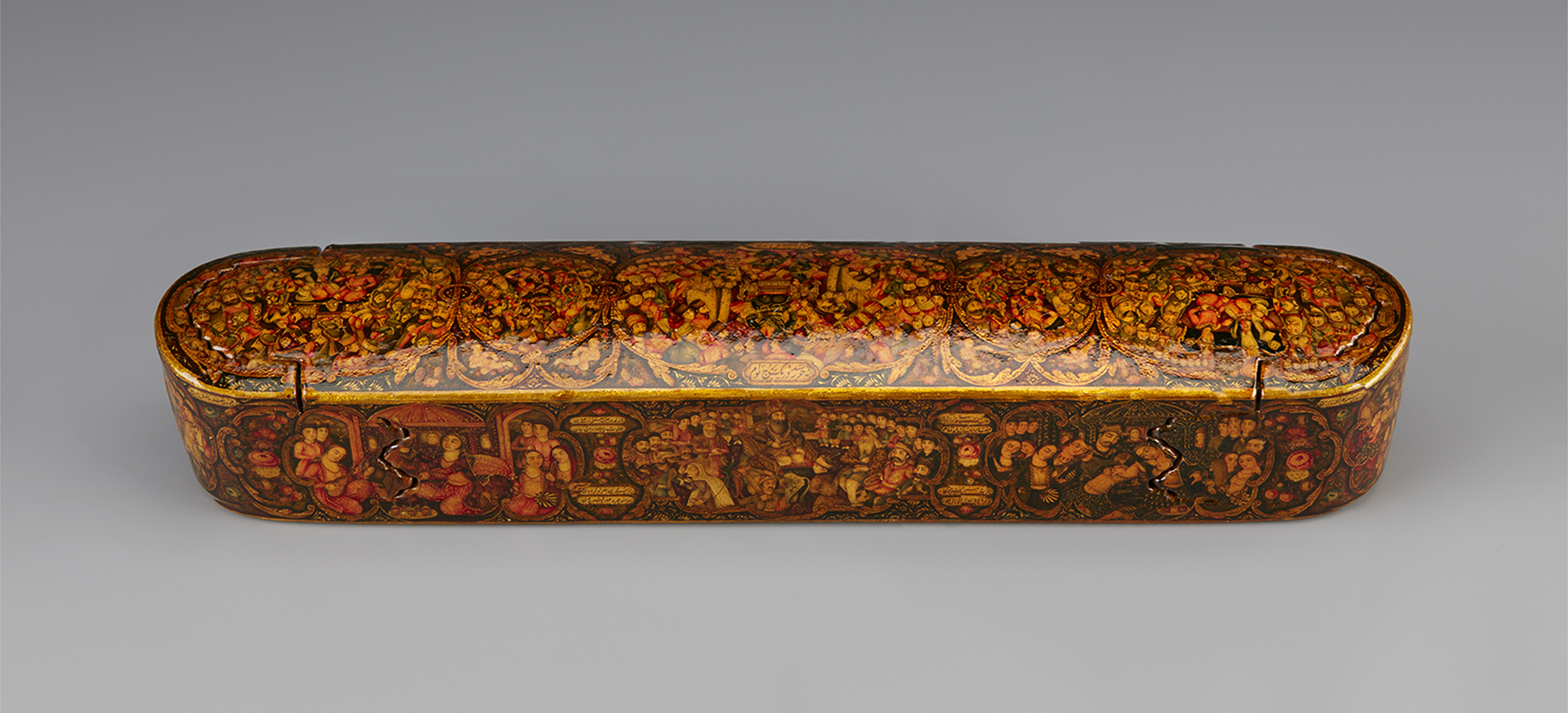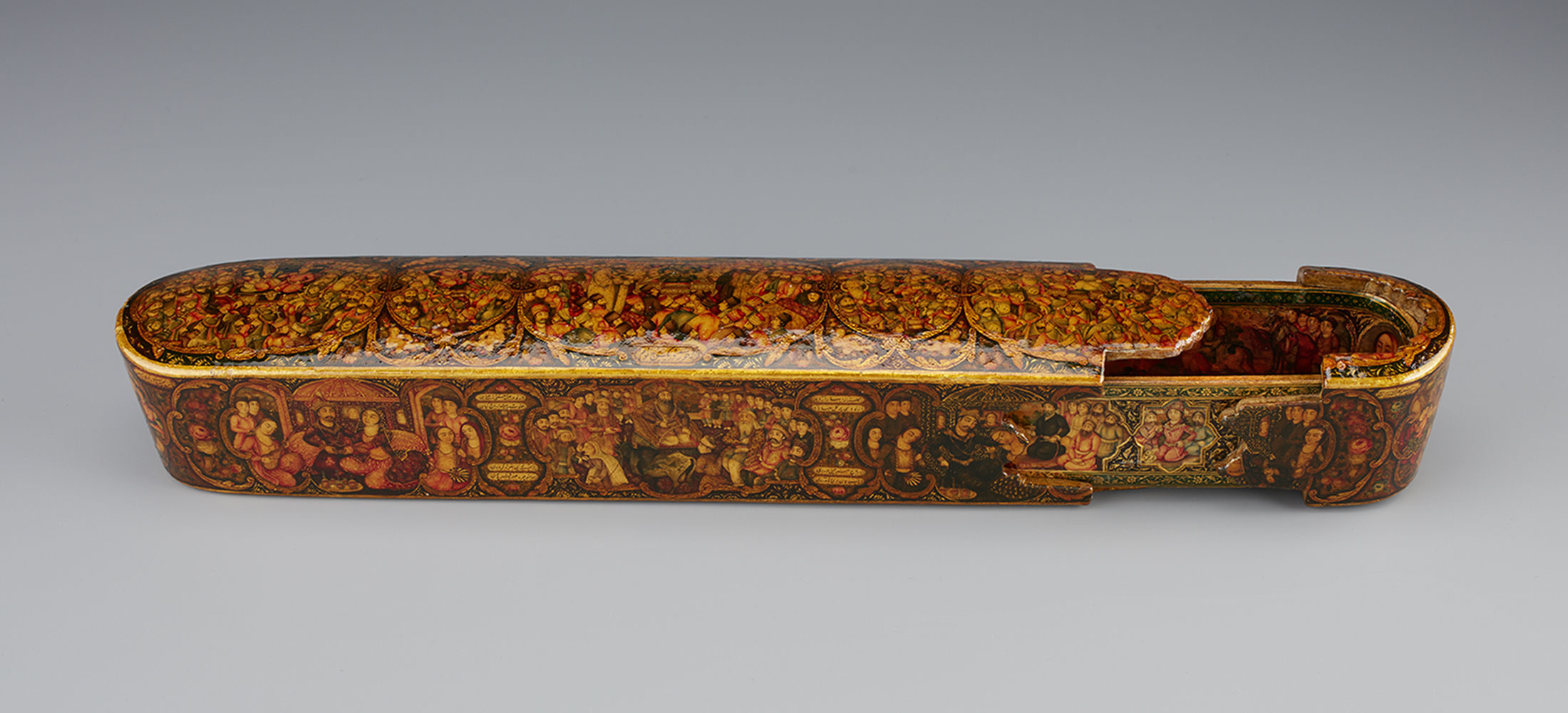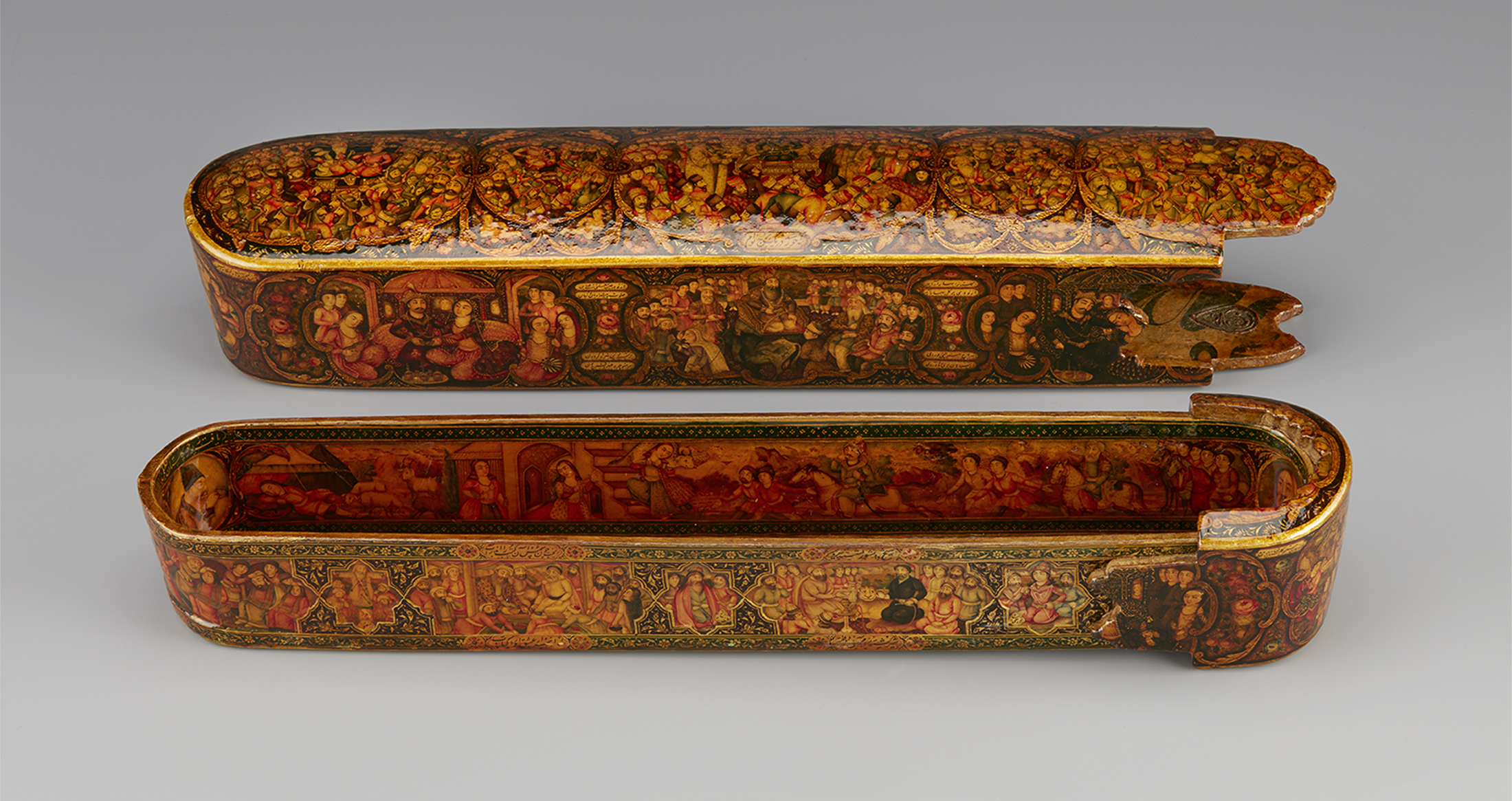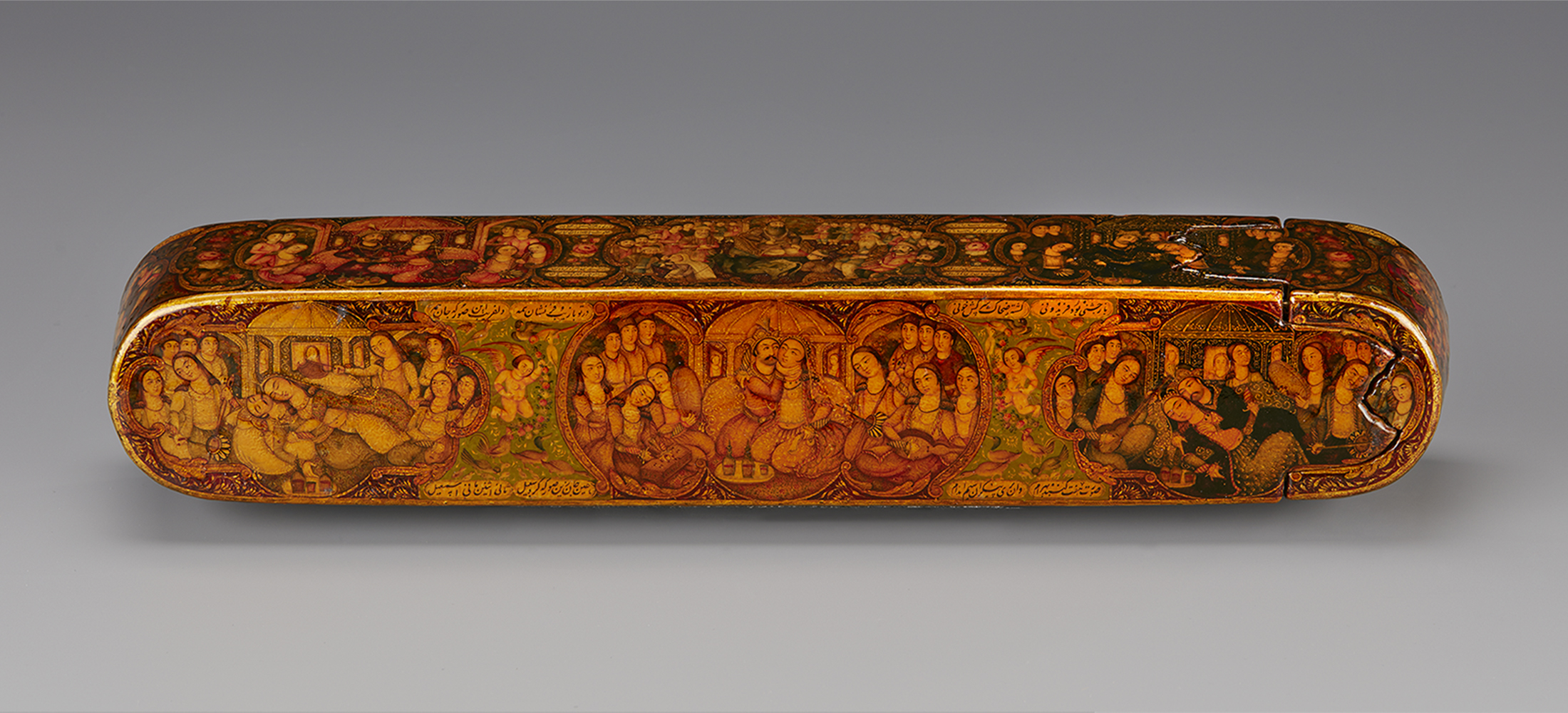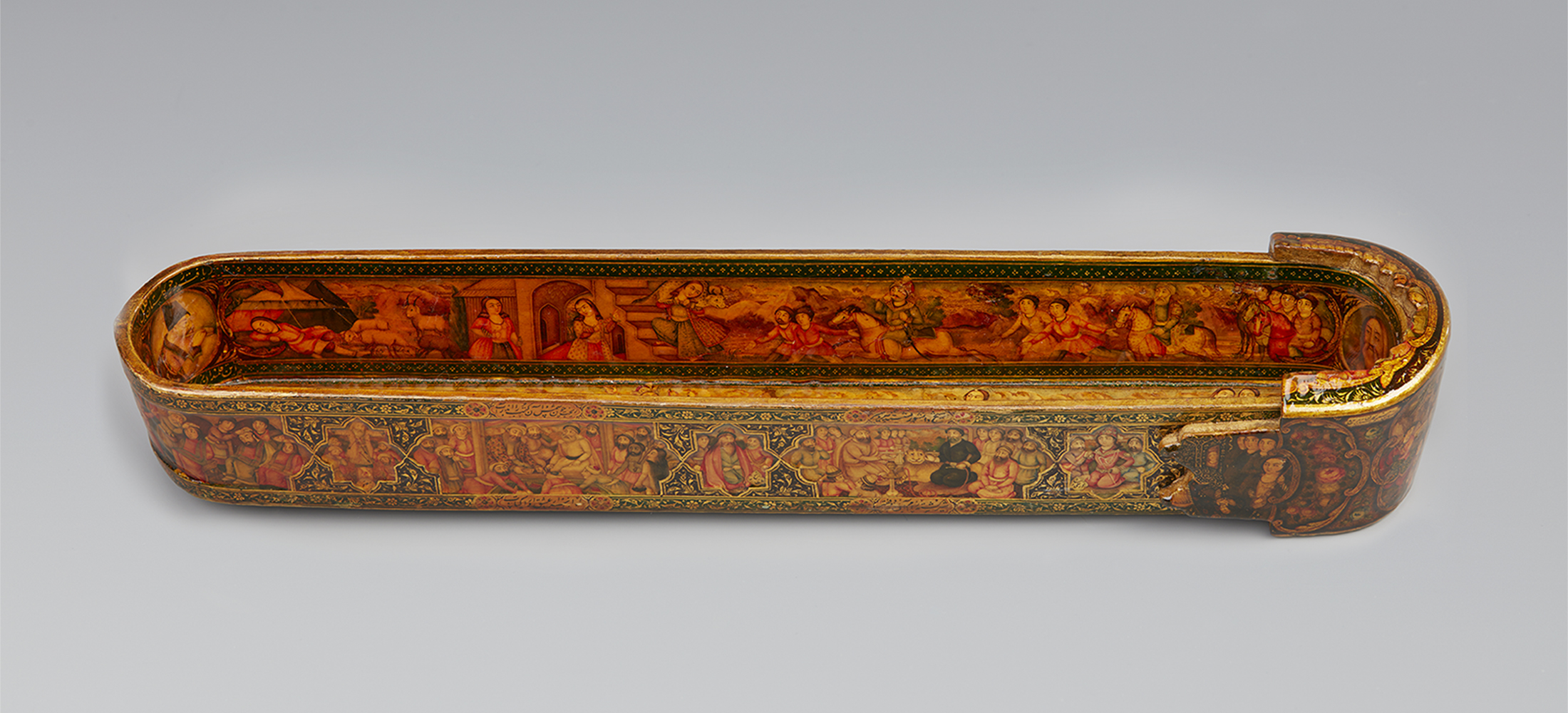Click on the image to zoom
Kiyani pen box
- Accession Number:AKM643
- Place:Iran
- Dimensions:26.8 cm
- Date:AH 1282/1864-65 AD
- Materials and Technique:papier-mâché, painted and lacquered
This extraordinary lacquer pen box is by Muhammad Ismaʻil Isfahani (active 1847–71), one of the foremost lacquer painters of second half of the 19th century in Iran. [1] Known as “kiyani” or “imperial,” such pen boxes are particular to the reign of Nasir al-Din Shah Qajar (r. 1848–96), and feature audience or darbar scenes celebrating his rule by placing him in the line of Persian mythical and historic kings. Isfahani’s signature style is evident in the dense and detailed compositions packed with minute figures that show the influence of European artistic traditions. A large cartouche depicting Nasir al-Din Shah Qajar and his court at the centre of the lid suggests that the pen box was made expressly for him, perhaps as a gift commemorating one of his yearly audiences. Here, the painter aggrandizes the shah by contextualizing his rule within the history of Persian kingship and highlighting the refined literary and cultural milieu of his court.
Further Reading
The pen box is made of two compartments. Every surface—including the interiors, the ends, and bottoms of each compartment—is covered with minute paintings depicting royal audience scenes of legendary and historic kings of Persia; literary narratives from epic and romantic poetic texts such as the Shahnameh of Firdausi, the Khamsa of Nizami, and Sufi tales; and portraits of renowned Sufi personages and poets.
The focal point of the box is the image of Nasir al-Din Shah enthroned with his grand vizier (sepahsalar) at his side surrounded by members of his court. These figures are all framed by an elaborate cartouche, which is in turn flanked by cherubim and accompanied by the following verses:
Alongside the shah, his grand vizier
Like the moon and the sun united in one constellation
Two smaller cartouches on either side of the central image feature the courts of the mythical kings from the Shahnameh: on the right, Kay Kavus and Faridun, and on the left, Kay Khusrau and Manuchihr. The rounded ends, [2] the sides, and underside of the frame depict the court of Sasanian King Khusrau I Anoushiravan (the Just) and popular stories from the Khamsa of Nizami, such as the story of Sultan Sanjar and the old woman, the Haft Paykar (Seven Beauties from the Khamseh), and the story of Bahram Gur and Fitna hunting. The scenes from the allegorical romance, the Haft Paykar show the Sasanian king Bahram V (r. 420–38) in romantic pursuit of his seven brides in the seven domed pavilions. Here, of course, the stories of the Haft Paykar can be “read” on two levels: as a manifestation of carnal love and as a spiritual quest for virtue and perfect union with the Divine.
Many of these images bear inscriptions and poetic verses in nastaʻliq script that directly refer to the scenes and the figures and praise the beauty of the pen box and the talents of its creator. A close reading of the poetry indicates that it was specifically composed, perhaps by the court poet, for this particular object. For example, the verses around the large frame read:
(right side)
Spring adorned the flower garden / You brought spring blossoms to winter (the month of Day [January])
Look what you have brought to every garden of art / [On the road] from Isfahan to Rayy
(left side)
You make manifest / The portraits of the Pishdadian and Kayanid kings
[Seated] on thrones under canopies / The moon is Manuchehr and Sun Fereydoun
(other side, right):
…. The brilliant skies, the [celestial] scenes of Bahram / Every seven days [of the week] until the month ends
The feast Anushiravan the lion-hunter / The memory of the woman, the cow and the hurt Zal
(other side, left):
And with the triumphant [-mannered] Kasra (Khusrau) /The secrets of the owls and the devastation of the land
Cried out at Sanjar’s soldier / that old woman with a sharp tongue
The exterior surfaces of the sliding compartment of the box, which would have held the reed pen and other implements, bear vignettes depicting popular Sufi tales such as the story of Beyazid Bistami [3] (d. 874–5 or 848–9) and Ibrahim Adham [4] (718–82), and portraits of the masters of the Niʻmatullahi Sufi order such Nur ʻAli Shah, Maʻsum ʻAli Shah, Fayz ʻAli Shah, Rajab ʻAli interspersed with related poetic verses.
The interior features several medallions with portraits of renowned Sufi personages such as Mansur Hallaj (b. 858–922) [5] and poets namely Shaykh ʻAttar (1145–1221), [6] Baba Taher ʻUryan (d. 937–8), Baba Rukn (d. 1368), and Baba ʻUbaydullah Khan (b. 687). The bottom and one side of the sliding compartment depict scenes from the story of Bahram Gur and slave girl Fitnah hunting accompanied by rhyming couplets; one depicts Bahram Gur pinning the ear to the tail of an onager as Fitnah watches in astonishment, and the other shows her carrying the ox up the stairs as Bahram observes her strength.
In addition to these portraits and tales of love and longing, a self-portrait of the painter wearing spectacles and holding a brush is enclosed in medallions and accompanied by a verse and a date:
Was adorned like a glorious flower-garden
This pen box with the pen of Ismaʻil, 1282
As a celebration of Persian kingship, this pen box served as the prototype for several kiyani pen boxes that followed, introducing a new iconography that was followed later by generations of lacquer painters. Masterfully painted, it is not only a celebration of Nasir al-Din Shah’s rule in the context of the history of Persian kingship, but also a window into the literary, spiritual, and mystical facets of his court.
— Maryam Ekhtiar
Notes
[1] See examples in the Metropolitan Museum of Art (2014.258) and the Nasser D Khalili Collection.
[2] A couplet of poetry on one rounded end of the frame reads:
The portraits of Kaykhusrau and Kaykavus
Zal, Gudarz, Giv and Rustam of Tus
Another couplet on the rounded end of the frame on the other side reads:
This pen box with its marvelous and exquisite paintings
Steals the heart like an enchanting flower-garden
[3] Bayazid Bistami (also known as Sultan al-Arifin) was a Persian Sufi of Zoroastrian descent who was a pioneer of the “drunken” or “ecstatic” (sukr) school of Islamic mysticism.
[4] Abu Ishaq Ibrahim ibn Adham was born in Balkh. He is one of the earliest documented great Sufis. He was king of Balkh and renounced the throne for a spiritual kingdom, wandering in order to live a life of complete asceticism.
[5] Persian mystic (wandering dervish), poet and master known for uttering the words “Ana al-Haqq” (I am the Truth), which many saw as a claim to divinity. He was considered a heretic by many and subsequently martyred in 922 AD.
[6] Sufi poet, mystical philosopher from Nishapur whose poetry had a lasting influence. His chief works include Divan, Mantiq al-Tayr (Conference of the Birds) and the Elahi-nameh.
References
Aga Khan Trust for Culture. Architecture in Islamic Arts: Treasures of the Aga Khan Museum. Geneva: Aga Khan Trust for Culture, 2011. ISBN: 9780987846303
---. Masterpieces of Islamic Art: Treasures of the Aga Khan Museum. Geneva: Aga Khan Trust for Culture, 2010. ISBN: 9783894796037
---. Spirit & Life: Masterpieces of Islamic Art from the Aga Khan Museum Collection. Geneva: Aga Khan Trust for Culture, 2007.ISBN: 9782940212022
---. Splendori a Corte, Arti del Mondo Islamico dalle collezioni del Museo Aga Khan, Milan: Edizioni Olivares/Aga Khan Trust for Culture, 2007. ISBN: 8885982948
---. The Path of Princes: Masterpieces from the Aga Khan Museum. Geneva: Aga Khan Trust for Culture, 2008.
Akbarnia, Ladan, Michael Barry, Sheila R. Canby, Azim Nanji, and Fernando Valdés. The Worlds of Islam in the collection of the Aga Khan Museum. Barcelona: Caixa Forum/Aga Khan Trust for Culture, 2009. ISBN: 978-84-9900-013-8
---. Treasures of the Aga Khan Museum, Arts of the Book & Calligraphy. Geneva: Aga Khan Trust for Culture, 2010. ISBN: 9786054348084
Akbarnia, Ladan, Michael Barry, Sheila R. Canby, Azim Nanji, and Fernando Valdés. The Worlds of Islam in the collection of the Aga Khan Museum. Barcelona: Caixa Forum/Aga Khan Trust for Culture, 2009. ISBN: 978-84-9900-013-8
Diba, Layla S. and Maryam, Ekhtiar, Royal Persian Paintings: The Qajar Epoch 1785-1925, London: I.B. Taurus, 1998. ISBN: 9781860642555
Ekhtiar, Maryam. “Muhammad Ismaʻil Isfahani: Master Lacquer Painter.” In Persian Masters: Five Centuries of Painting, ed. Sheila Canby. Mumbai: Marg Publications, 1990. ISBN: 9788185026107
Karimzadeh-Tabrizi, Muhammad Ali. The Lives and Art of the Old Painters of Iran, Vol. 1. London, 1990, 71-73. ISBN: 9781872302034
Robinson, Basil W. "Qajar lacquer." Murqarnas 6, 1989: 131–46. ISBN: 9789004090507
Note: This online resource is reviewed and updated on an ongoing basis. We are committed to improving this information and will revise and update knowledge about this object as it becomes available.






